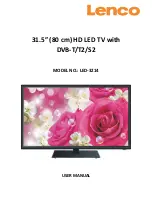
8
(E) 32HL83
Connecting
y
our T
V
Connecting your TV
Note:
One TheaterLink cable is provided with your TV. No other cables
are provided.
Coaxial cable
is the cable that comes in from your antenna, cable TV
service, or cable converter box. Coaxial cable has “F” connectors.
Standard stereo A/V cables
usually come in sets of three, and are
typically color-coded according to use: yellow for video, red for stereo
right audio, and white for stereo left (or mono) audio. Your TV’s standard
A/V inputs are color-coded in the same manner as the cables.
S-video cable
is for use with video equipment that has an S-Video
connector.
Component video cables
come in sets of three (typically color-coded
red, green, and blue), and are for use with video equipment that has
component video connectors. Your TV’s ColorStream
®
(component video)
inputs are color-coded in the same manner as the cables.
DVI-D digital single-link cable
is for use with video equipment that has
a DVI-D digital single-link connector (see page 15).
TheaterLink cable
is used to remotely control other A/V equipment
(equipped with an infrared sensor) through the TV (see page 16).
NOTE REGARDING PICTURE QUALITY
When connecting video equipment to your Toshiba TV:
For GOOD picture quality:
Use a
standard stereo A/V (yellow)
video
cable.
For BETTER picture quality:
If your equipment has an
S-video
connector, use an S-video cable
instead of
a standard yellow video cable.
(You still must connect the standard red and white audio cables for full
system connection, but
do not connect a standard yellow video cable at
the same time
or the picture performance will be unacceptable.)
For BEST picture quality:
If your equipment has
component video
connectors, use component video cables
instead of
a standard yellow
video cable or an S-video cable (plus the standard red and white audio
cables for full system connection.) If your equipment has a
DVI-D
digital single-link connector
, use a DVI-D cable (plus standard red
and white audio cables connected to the audio terminals labeled “For
DVI/HDCP IN” for full system connection).
Component video cables
(typically color-coded red, green, blue)
Coaxial (antenna) cable
Standard stereo A/V cables
(typically color-coded yellow for video,
red and white for audio)
S-video cable
CAUTION:
Do not plug in any power cords until you have
finished connecting all equipment.
DVI-D digital single-link cable
TheaterLink cable









































